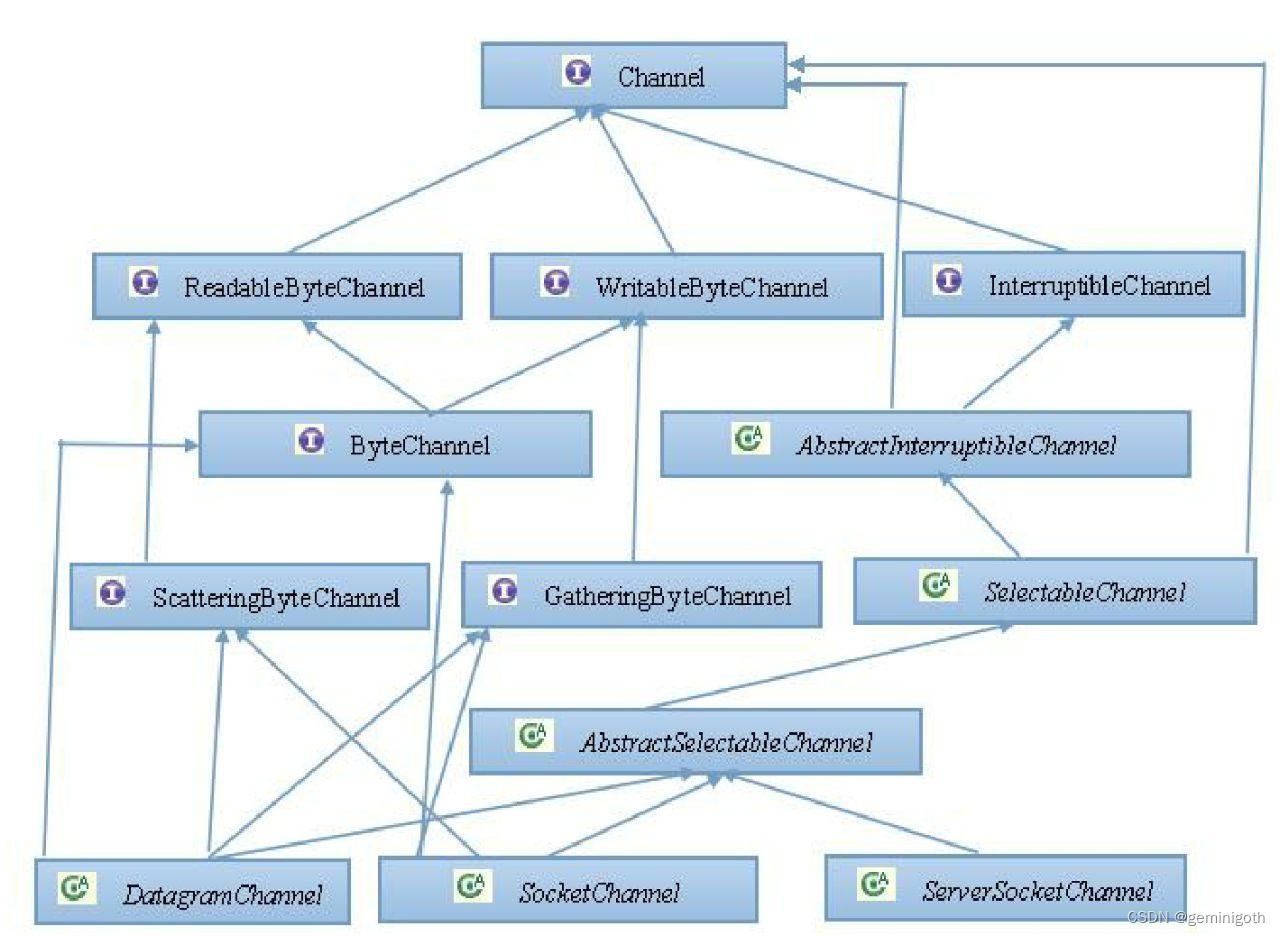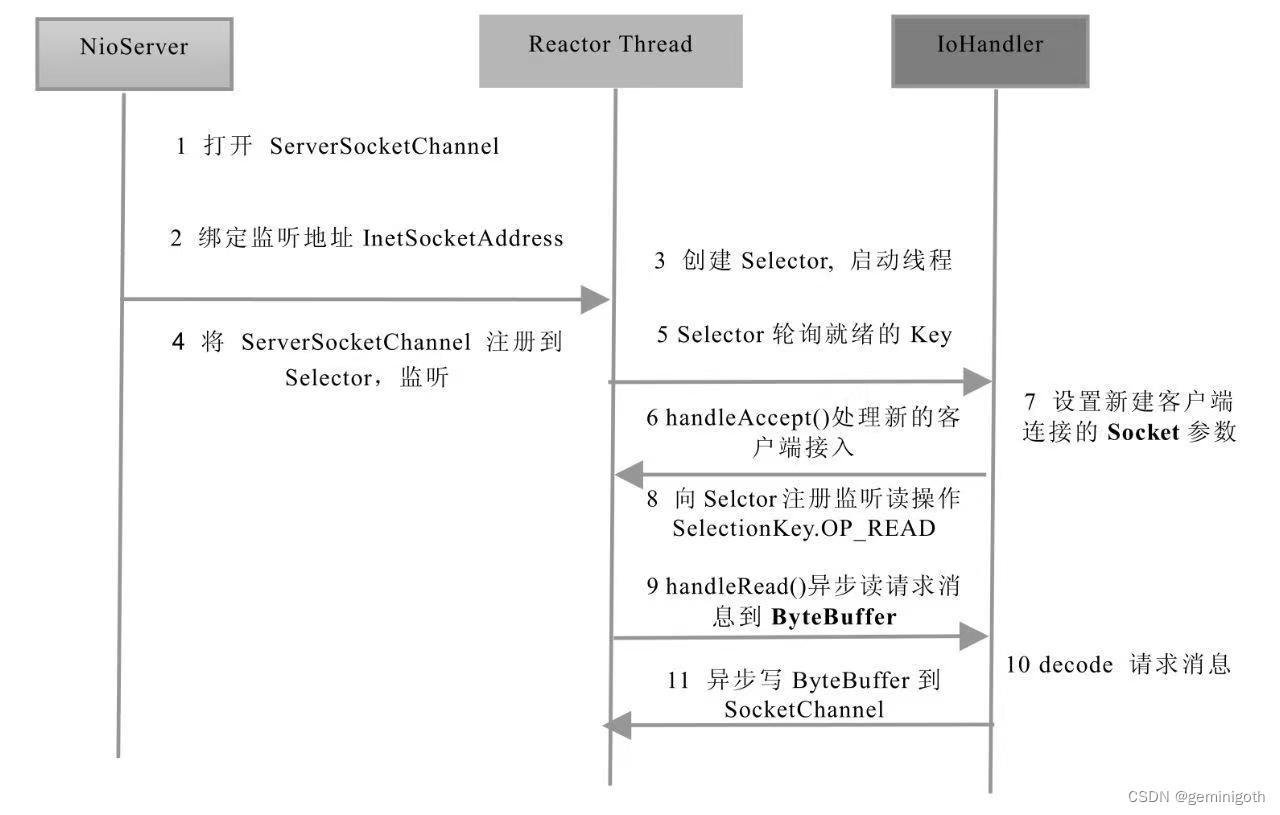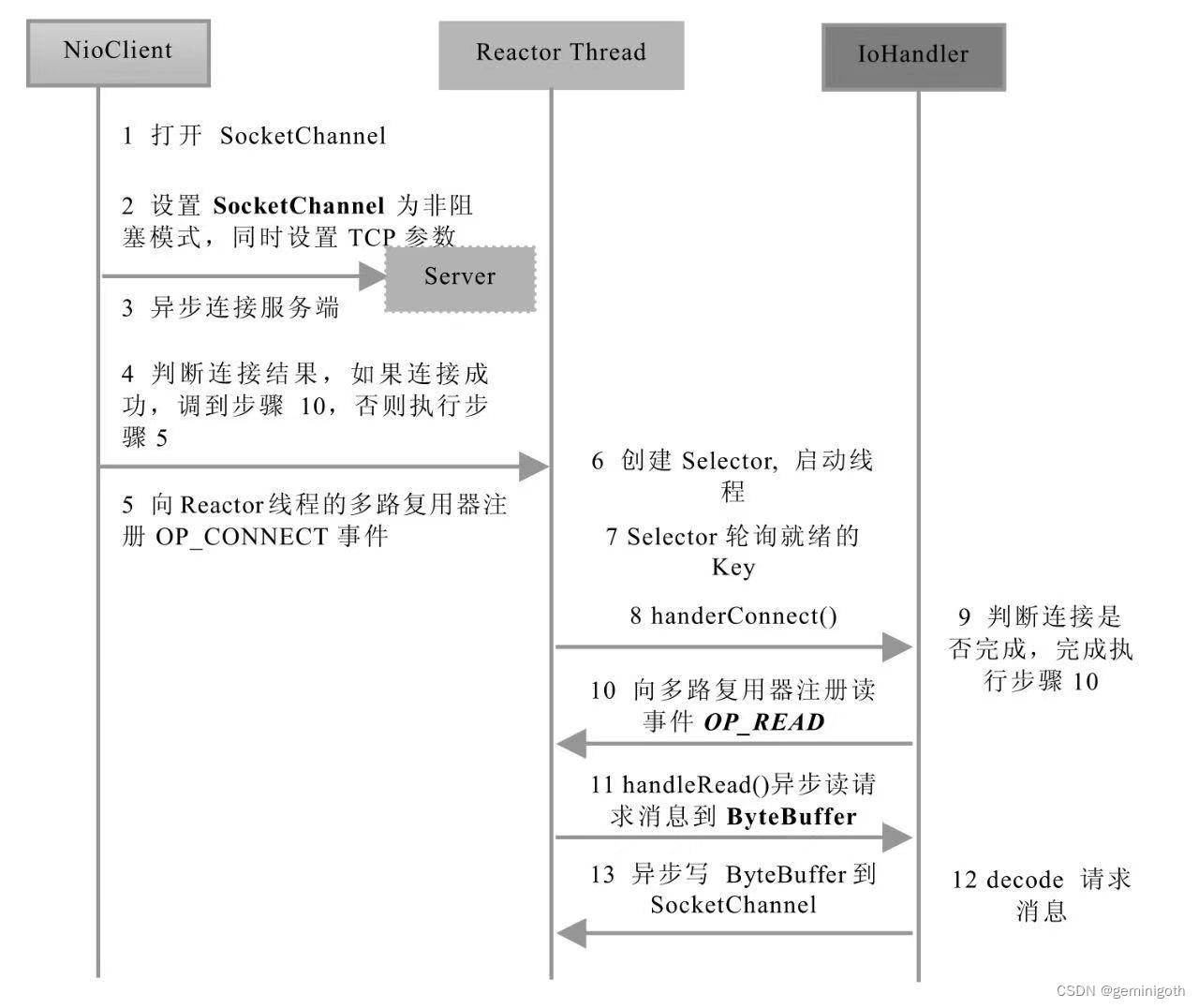Netty权威指南——基础篇2(NIO编程)备份
1 概述
与Socket类和ServerSocket,NIO也提供了SocketChannel和ServerSocketChannel两种不同的套接字通道实现。这两种新增的通道都支持阻塞和非阻塞两种模式。阻塞模式使用简单,但性能和可靠性都不好,非阻塞模式则正好相反。一般来说,低负载、地并发的应用程序可以选择同步阻塞I/O降低变成复杂度;对于高负载、高并发的网络应用,需要使用NIO的非阻塞模型进行开发。
2 NIO类库简介
新的输入/输出(NIO)库是在JDK 1.4中引入的。NIO弥补了原来同步阻塞I/O的不足,它在标准java代码中提供了高速、面向块的I/O。通过定义包含数据的类,以及通过以块的形式处理这些数据,NIO不用使用本机代码就可以利用低级优化,这是原来的I/O无法做到的。
2.1 缓冲区Buffer
首先介绍缓冲区(Buffer)的概念。Buffer是一个对象,它包含一些要写入或者要读出的数据。在NIO类库中加入Buffer对象,体现了新库与原I/O的一个重要区别。在面向流的I/O中,可以将数据直接写入或者将数据直接读到Stream对象中。
在NIO库中,所有数据都是用缓冲区处理的。在读取数据时,它是直接读到缓冲区中;在写入数据时,也是写入到缓冲区中。任何使用访问NIO中的数据,都是通过缓冲区进行操作。
缓冲区实质上是一个数组。通常它是一个字节数组(ByteBuffer),也可以使用其他类型的数据。但是一个缓冲区不仅仅是一个数组,缓冲区提供了对数据的结构化访问以及维护读写位置等信息。
最常用的缓冲区是ByteBuffer,一个ByteBuffer提供了一组功能用于操作byte数据。除了ByteBuffer,还有其他的一些 缓冲区,实际上,每一种java基本类型(除了boolean类型)都对应有一种缓冲区,具体如下:
1、ByteBuffer:字节缓冲区
2、CharBuffer:字符缓冲区
3、ShortBuffer:短整型缓冲区
4、IntBuffer:整型缓冲区
5、LongBuffer:长整型缓冲区
6、FloatBuffer:浮点型缓冲区
7、DoubleBuffer:双精度浮点型缓冲区
缓冲区的类图继承关系如下:

每一个Buffer类都是Buffer接口的一个子实例。除了ByteBuffer,每一个Buffer类都有完全一样的操作,只是它们所处理的数据类型不一样。因为大多数标准I/O操作都是用ByteBuffer,所以它在具有一般缓冲区的操作之外还提供了一些特有的操作,以方便网络读写。
2.2 通道Channel
Channel是一个通道,就像自来水管一样,网络数据通过Channel读取和写入。通道与流的不同至于在于通道时双向的,流只是在一个方向上移动(一个流必须是InputStream或OutputStream的子类),而通道可用于读、写或者二者同时进行。
因为Channel是全双工的,所以它可以比流更好的映射底层操作系统的API。特别是在UNIX网络编程模型中,底层操作系统的通道全都是全双攻的,同时支持读写操作。
Channel的类图继承关系如下:

自顶向下看,前三层主要是Channel接口,用于定义它的功能,后面是一些具体的功能类(抽象类)。从图中可以看出,实际上Channel分为两大类:用于王立国读写的SelectableChannel和用于文件操作的FileChannel。
2.3 多路复用器Selector
多路复用器Selector,它是Java NIO编程的基础,熟练地掌握Selector对于NIO编程至关重要。多路复用器提供选择已经就绪的任务的能力。简单来说,Selector会不断地轮询注册在其上的Channel,如果某个Channel上面发生读写事件,这个Channel就处于就绪状态,会被Selector轮询出来,然后通过SelectionKey可以获取就绪Channel的集合,记性后续的I/O操作。
一个多路复用器Selector可以同时轮询多个Channel,由于JDK使用了epoll代替传统的select实现,所以它并没有最大连接句柄1024/2048的限制。这样就意味着只需要一个Selector线程负责Selector的轮询,就可以接入成千上万个客户端。
3 NIO服务端序列图
NIO服务端通信序列图如下:

第一步:打开ServerSocketChannel,用于监听客户端的连接,它是所有客户端连接的父管道,示例代码如下:
ServerSocketChannel serverSocketChannel = ServerSocketChannel.open();第二步:绑定监听端口,设置连接为非阻塞模型,示例代码如下:
int port = 8080;
serverSocketChannel.socket().bind(new InetSocketAddress(InetAddress.getByName("IP"), port));
serverSocketChannel.configureBlocking(false);第三步:创建Reactor线程,创建多路复用器并启动线程,示例代码如下:
//创建Reactor线程
new Thread(new ReactorTask()).start();
//创建多路复用器
Selector selector = Selector.open();第四步:将ServerSocketChannel注册到Reactor线程的多路复用器Selector上,监听ACCEPT事件,示例代码如下:
SelectionKey key = serverSocketChannel.register(selector, SelectionKey.OP_ACCEPT, ioHandler);第五步:多路复用器在线程run()方法的无限循环体内轮询准备就绪的key,示例代码如下:
int num = selector.select();
Set<SelectionKey> selectededKeys = selector.selectedKeys();
Iterator<SelectionKey> iterator = selectededKeys.iterator();
while(iterator.hasNext()){
SelectionKey key = (SelectionKey) iterator.next();
//do something
}第六步:多路复用器监听到有新的客户端接入,处理新的接入请求,完成TCP三次握手,建立物理链路,示例代码如下:
SocketChannel channel = serverSocketChannel.accept();第七步:设置客户端链路为非阻塞模式,示例代码如下:
channel.configureBlocking(false);
channel.socket().setReuseAddress(true);第八步:将新接入的客户端连接注册到Reactor线程的多路复用器上,监听读操作,读取客户端发送的网络消息,示例代码如下:
SelectionKey selectionKey = channel.register(selector, SelectionKey.OP_READ);第九步:异步读取客户端请求消息到缓冲区,示例代码如下:
long read = channel.read(new ByteBuffer[1024]);第十步:对ByteBuffer进行编解码,如果有半包消息指针reset,继续读取后续的报文,将解码成功的消息封装成Task,投递到业务线程池中,进行业务逻辑编排,示例代码如下:
List<Object> messageList = new ArrayList<>();
ByteBuffer buffer = ByteBuffer.allocate(1024);
while(buffer.hasRemaining()){
buffer.mark();
Object message = decode(buffer);
if(message == null){
buffer.reset();
break;
}
messageList.add(message);
}
if(!buffer.hasRemaining()){
buffer.clear();
}else{
buffer.compact();
}
if(messageList != null && ! messageList.isEmpty()){
for(Object m : messageList){
handlerTask(m);
}
}第十一步:将POJO对象encode成ByteBuffer,调用SocketChannel的异步write方法,将消息异步发送给客户端,示例代码如下:
channel.write(buffer);【注意】如果发送区TCP缓冲区满,会导致写半包,此时,需要注册监听写操作位,循环写,直到整包消息写入TCP缓冲区。
以上11步就是NIO服务器序列,整体示例代码如下:(不要运行,仅供参考)
public class NIOStep {
public static void main(String[] args) throws IOException {
//创建ServerSocketChannel,用于监听客户端连接
ServerSocketChannel serverSocketChannel = ServerSocketChannel.open();
//端口号
int port = 8080;
//设置IP地址和端口号
serverSocketChannel.socket().bind(new InetSocketAddress(InetAddress.getByName("IP"), port));
//设置连接为非阻塞模式
serverSocketChannel.configureBlocking(false);
//创建Reactor线程
new Thread(new ReactorTask()).start();
//创建多路复用器
Selector selector = Selector.open();
//将ServerSocketChannel注册到Reactor线程的多路复用器Selector上,监听ACCEPT事件
SelectionKey keys = serverSocketChannel.register(selector, SelectionKey.OP_ACCEPT, ioHandler);
//Selector在run方法内轮询准备就绪的key
int num = selector.select();
Set<SelectionKey> selectededKeys = selector.selectedKeys();
Iterator<SelectionKey> iterator = selectededKeys.iterator();
while(iterator.hasNext()){
SelectionKey key = (SelectionKey) iterator.next();
//do something
}
SocketChannel channel = serverSocketChannel.accept();
channel.configureBlocking(false);
channel.socket().setReuseAddress(true);
SelectionKey selectionKey = channel.register(selector, SelectionKey.OP_READ);
long read = channel.read(new ByteBuffer[1024]);
List<Object> messageList = new ArrayList<>();
ByteBuffer buffer = ByteBuffer.allocate(1024);
while(buffer.hasRemaining()){
buffer.mark();
Object message = decode(buffer);
if(message == null){
buffer.reset();
break;
}
messageList.add(message);
}
if(!buffer.hasRemaining()){
buffer.clear();
}else{
buffer.compact();
}
if(messageList != null && ! messageList.isEmpty()){
for(Object m : messageList){
handlerTask(m);
}
}
channel.write(buffer);
}
}4 NIO创建TimeServer
TimeServer.java 代码
public class TimeServer {
public static void main(String[] args) {
int port = 8080;
MultiplexerTimeServer timeServer = new MultiplexerTimeServer(port);
new Thread(timeServer,"NIO-MultiplexerTimeServer-001").start();
}
}其中,
MultiplexerTimeServer timeServer = new MultiplexerTimeServer(port);创建了一个被称为 MultiplexerTimeServer的多路复用类,它是一个独立的线程,负责轮询多路复用器Selector,可以处理多个客户端的并发接入。
MultiplexerTimeServer.java 代码
package com.jay.NIOBASIC;
import java.io.IOException;
import java.net.InetSocketAddress;
import java.net.Socket;
import java.nio.ByteBuffer;
import java.nio.channels.SelectionKey;
import java.nio.channels.Selector;
import java.nio.channels.ServerSocketChannel;
import java.nio.channels.SocketChannel;
import java.util.Date;
import java.util.Iterator;
import java.util.Set;
public class MultiplexerTimeServer implements Runnable{
private Selector selector;
private ServerSocketChannel serverSocketChannel;
private volatile boolean stop;
//初始化多路复用器,绑定监听端口
public MultiplexerTimeServer(int port){
try {
selector = Selector.open();
serverSocketChannel = ServerSocketChannel.open();
serverSocketChannel.configureBlocking(false);
serverSocketChannel.socket().bind(new InetSocketAddress(port),1024);
serverSocketChannel.register(selector, SelectionKey.OP_ACCEPT);
System.out.println("TimeServer 开始启动,端口是:"+port);
}catch (IOException e){
e.printStackTrace();
System.exit(1);
}
}
public void stop(){
this.stop = true;
}
@Override
public void run(){
while(!stop){
try {
selector.select(1000);
Set<SelectionKey> selectededKeys = selector.selectedKeys();
Iterator<SelectionKey> it = selectededKeys.iterator();
SelectionKey key = null;
while(it.hasNext()){
key = it.next();
it.remove();
try {
handlerInput(key);
}catch (Exception e){
if(key != null){
key.cancel();
if(key.channel() != null){
key.channel().close();
}
}
}
}
}catch (Throwable t){
t.printStackTrace();
}
}
//多路复用器关闭后,所有注册到上面的Channel和Pipe等资源都会被自动取注册并关闭,所有不需要重复释放资源
if(selector != null){
try {
selector.close();
}catch (IOException e){
e.printStackTrace();
}
}
}
private void handlerInput(SelectionKey key) throws IOException{
if(key.isValid()){
//处理新接入的请求消息
if(key.isAcceptable()){
ServerSocketChannel ssc = (ServerSocketChannel) key.channel();
SocketChannel sc = ssc.accept();
sc.configureBlocking(false);
sc.register(selector,SelectionKey.OP_READ);
}
//处理读取的请求消息
if(key.isReadable()){
SocketChannel sc = (SocketChannel) key.channel();
ByteBuffer readBuffer = ByteBuffer.allocate(1024);
int readBytes = sc.read(readBuffer);
if(readBytes > 0){
readBuffer.flip();
byte[] bytes = new byte[readBuffer.remaining()];
readBuffer.get(bytes);
String body = new String(bytes,"UTF-8");
System.out.println("TimeServer 接收:"+body);
String currentTime = "query".equalsIgnoreCase(body) ? new Date(System.currentTimeMillis()).toString() : "bad";
doWrite(sc,currentTime);
}else if(readBytes < 0){
//对端链路关闭
key.cancel();
sc.close();
}else{
//读到0字节,忽略
}
}
}
}
private void doWrite(SocketChannel channel,String response) throws IOException {
if(response != null && response.trim().length() > 0){
byte[] bytes = response.getBytes();
ByteBuffer writeBuffer = ByteBuffer.allocate(bytes.length);
writeBuffer.put(bytes);
writeBuffer.flip();
channel.write(writeBuffer);
}
}
}
代码分析:
1、MultiplexerTimeServer()是构造方法,在构造方法中进行资源初始化。创建多路复用器Selector、ServerSocketChannel,对Channel和TCP参数进行配置。系统资源初始化成功后,将ServerSocketChannel注册到Selector,监听SelectionKey.OP_ACCEPT操作位。如果初始化失败则退出。
2、run()方法,在while循环体中循环遍历selector,它的休眠时间为1秒。无论是否有读写等时间发生,selector每个1秒被唤醒一次。selector也提供了一个无参的select方法:当有处于就绪状态的Channel时,selector将返回该Channel的SelectionKey集合。通过对就绪状态的Channel集合进行迭代,可以进行网络的异步读写操作。
3、handlerInput方法中的
if(key.isAcceptable()){}
分支处理新接入的客户端请求消息,根据SelectionKey的操作位进行判断即可获取网络事件的类型,通过ServerSocketChannel的accept接收客户端的连接请求并创建SocketChannel实例。完成上述操作后,相当月完成了TCP的三次握手,TCP物理链路正式建立。
4、handlerInput方法中的
if(key.isReadable()){}分支用于读取客户端的请求消息。首先创建一个ByteBuffer,用于事先无法得知客户端发送的码流大小,作为例程,开辟了一个1MB的缓冲区。然后调用SocketChannel的read方法读取请求码流。注意,由于已经将SocketChannel设置为异步非阻塞模式,因此它的read是非阻塞的,使用返回值进行判断,看读取到的字节数,返回值有以下三种可能的结果:
(1)返回大于0:读到了字节,对字节进行编解码;
(2)返回值等于0:没有读取到字节,属于正常场景 ,忽略;
(3)返回值为-1:链路已经关闭,需要关闭SocketChannel,释放资源。
当读取到码流以后,进行解码。首先对readBuffer进行flip操作,它的作用是将缓冲区当前的limit设置为position,position设置为0,用于后续对缓冲区的读取操作。然后根据缓冲区可读的字节个数创建字节数组,调用ByteBuffer的get方法将缓冲区可读的字节数组复制到新创建的字节数组中,最后调用字符串的构造函数创建请求体并打印。如果请求指令是“query”,则把服务器的当时时间编码后返回给客户端。
5 doWrite方法:
将应答消息异步发送给客户端。首先将字符串编码成字节数组,根据字节数组的容量创建ByteBuffer,调用put方法将字节数组复制到缓冲区中,然后对缓冲区进行flip操作,最后调用SocketChannel的write方法将缓冲区中的字节数组发送出去。需要指出的是,由于SocketChannel是异步非阻塞的,并不保证一次能够把需要发送的字节数组发送完,此时会出现“写半包”问题。需要注册写操作,不断轮询Selector将没有发送完的ByteBuffer发送完毕,然后可以通过hasRemain方法判断消息是否发送完成。此处仅仅是简单的入门级示例,后续会演示如何处理“写半包”的场景。
5 NIO客户端序列图

第一步:打开SocketChannel,绑定客户端本地地址
SocketChannel clientChannel = SocketChannel.open();第二步:设置SocketChannel为非阻塞模式,同时设置客户端连接的TCP参数
Socket socket = new Socket();
socket.setReuseAddress(true);
socket.setReceiveBufferSize(BUFFER_SIZE);
socket.setSendBufferSize(BUFFER_SIZE);第三步:异步连接服务端
boolean connect = clientChannel.connect(new InetSocketAddress("127.0.0.1", 8080));第四步:判断是否连接成功,如果成功,则直接注册读状态位到多路复用器中,如果失败(异步连接,返回false,说明客户端已经发送sync包,服务度没有返回ack包,物理链路还没有建立)
selector = Selector.open();
if(connect){
clientChannel.register(selector, SelectionKey.OP_READ,ioHandler);
}else{
clientChannel.register(selector,SelectionKey.OP_CONNECT,ioHandler)
}第五步:向Reactor线程的多路复用器注册OP_CONNECT状态位,监听服务端的TCP ACK应答
clientChannel.register(selector,SelectionKey.OP_CONNECT,ioHandler);第六步:创建Reactor线程,创建多路复用器并启动线程
selector = Selector.open();
new Thread(new ReactorTask()).start();第七步:多路复用器在线程run方法的无限循环体内轮询准备就绪的key
int num = selector.select();
Set<SelectionKey> selectededKeys = selector.selectedKeys();
Iterator<SelectionKey> it = selectededKeys.iterator();
while(it.hasNext()){
SelectionKey key = (SelectionKey) it.next();
}第八步:接收connect事件进行处理
if(key.isConnectable()){
//处理
}第九步:判断连接成功,如果成功,注册读事件到多路复用器
if(clientChannel.finishConnect()){
registerRead();
}第十步:注册读事件到多路复用器
clientChannel.register(selector,SelectionKey.OP_READ,ioHandler);第十一步:异步读客户端请求信息到缓冲区
long read = clientChannel.read(new ByteBuffer[1024]);第十二步:对ByteBuffer进行编解码,如果有半包消息接收到缓冲区Reset,继续读取后续的报文,将解码成功的消息封装成 Task,投递到业务线程池中,进行业务逻辑编排。
第十三步:将POJO对象encode成ByteBuffer,调用SocketChannel的异步write接口,将消息异步发送给客户端
6 NIO创建TimeClient
TimeClient.java
public class TimeClient {
public static void main(String[] args) {
int port = 8080;
new Thread(new TimeClientHandler("127.0.0.1",port),"TimeClient-001").start();
}
}TimeClientHandler.java
package com.jay.NIOBASIC;
import java.io.IOException;
import java.net.InetSocketAddress;
import java.nio.ByteBuffer;
import java.nio.channels.SelectionKey;
import java.nio.channels.Selector;
import java.nio.channels.SocketChannel;
import java.util.Iterator;
import java.util.Set;
public class TimeClientHandler implements Runnable{
private String host;
private int port;
private Selector selector;
private SocketChannel socketChannel;
private volatile boolean stop;
public TimeClientHandler(String host,int port){
this.host = host == null ? "127.0.0.1" : host;
this.port = port;
try {
selector = Selector.open();
socketChannel = SocketChannel.open();
socketChannel.configureBlocking(false);
}catch (IOException e){
e.printStackTrace();
System.exit(1);
}
}
@Override
public void run(){
try {
doConnect();
}catch (IOException e){
e.printStackTrace();
System.exit(1);
}
while(!stop){
try {
selector.select(1000);
Set<SelectionKey> selectededKeys = selector.selectedKeys();
Iterator<SelectionKey> it = selectededKeys.iterator();
SelectionKey key = null;
while(it.hasNext()){
key = it.next();
it.remove();
try {
handleInput(key);
}catch (Exception e){
key.cancel();
if(key.channel() != null){
key.channel().close();
}
}
}
}catch (Exception e){
e.printStackTrace();
System.exit(1);
}
}
if(selector != null){
try {
selector.close();
}catch (IOException e){
e.printStackTrace();
}
}
}
private void handleInput(SelectionKey key) throws IOException{
if(key.isValid()){
//判断是否连接成功
SocketChannel sc = (SocketChannel)key.channel();
if(key.isConnectable()){
sc.register(selector,SelectionKey.OP_READ);
doWrite(sc);
}else{
System.exit(1);
}
if(key.isReadable()){
ByteBuffer readBuffer = ByteBuffer.allocate(1024);
int readBytes = sc.read(readBuffer);
if(readBytes > 0){
readBuffer.flip();
byte[] bytes = new byte[readBuffer.remaining()];
readBuffer.get(bytes);
String body = new String(bytes,"UTF-8");
System.out.println("now is : " + body);
this.stop = true;
}else if(readBytes < 0){
key.cancel();
sc.close();
}
}
}
}
private void doConnect() throws IOException{
//如果直接连接成功,则注册到多路复用器上,发送请求消息,读应答
if(socketChannel.connect(new InetSocketAddress(host,port))){
socketChannel.register(selector,SelectionKey.OP_READ);
doWrite(socketChannel);
}else{
socketChannel.register(selector,SelectionKey.OP_CONNECT);
}
}
private void doWrite(SocketChannel sc) throws IOException{
byte[] req = "query".getBytes();
ByteBuffer writeBuffer = ByteBuffer.allocate(req.length);
writeBuffer.put(req);
writeBuffer.flip();
sc.write(writeBuffer);
if(!writeBuffer.hasRemaining()){
System.out.println("发送 2 服务成功");
}
}
}
代码分析:
1、构造方法:用于初始化NIO的多路复用器和SocketChannel对象。需要注意的是,创建SocketChannel之后,需要将其设置为异步非阻塞模式。
2、run()方法中的doConnect方法用于发送连接请求,作为实例,连接是成功的,所以不需要做重连操作,因此将其放到循环之前。下面看doConnect方法实现,首先对SocketChannel的connect()操作进行判断。如果连接成功,则将SocketChannel注册到多路复用器Selector上,注册SelectionKey.OP_READ;如果没有直接连接成功,则说明服务端没有返回TCP握手应答消息,但这并不代表连接失败。需要将SocketChannel注册到多路复用器Selector上,注册SelectionKey.OP_CONNECT,当服务端返回TCP syn-ack消息后,Selector就能够轮询到这个SocketChannel处于连接就绪状态。
3、run()方法中while循环,轮询多路复用器Selector。当有就绪的Channel时,执行handleInput(key)方法。
4、handleInput(key)方法:首先对SelectionKey进行判断,看它处于什么状态。如果处于连接状态,说明服务端已经返回ACK应答消息。这是需要对连接结果进行判断,调用SocketChannel的finishConnect方法。如果返回值为true,说明客户端连接成功;如果返回值为false或者抛出异常,说明连接失败。本例中,返回值为true,说明连接成功。将SocketChannel注册到多路复用器上,注册SelectionKey.OP_READ操作位,监听网络读操作,然后发送请求消息给服务端。
5、doWrite方法:构造请求消息体,然后对其编码,写入到发送缓冲区中,最后调用SocketChannel的write方法进行发送。由于发送是异步的,所以会存在“半包写”问题,此处不再赘述。最后通过hasRemaining()方法对发送结果进行判断,如果缓冲区中的消息全部发送完成,打印“发送 2 服务成功”。
7 使用NIO编程优点
1、客户端发起的连接操作是异步的,可以通过在多路复用器注册OP_CONNECT等待后续结果,不需要像之前那样被同步阻塞。
2、SocketChannel的读写操作都是异步的,如果没有可读写的数据它不会同步等待,直接返回。这样I/O通信线程就可以处理其他的链路,不需要同步等待这个链路可用。
3、线程模型优化:由于JDK的Selector在Linux等主流操作系统上通过epoll实现,它没有连接句柄数的限制,这意味一个Selector线程可以同时处理成千上万个客户端连接,而且性能不会随着客户端的增加而线性下降。因此,非常适合做高性能、高负载的网络服务器。
原文地址:https://blog.csdn.net/geminigoth/article/details/136295978
免责声明:本站文章内容转载自网络资源,如本站内容侵犯了原著者的合法权益,可联系本站删除。更多内容请关注自学内容网(zxcms.com)!
